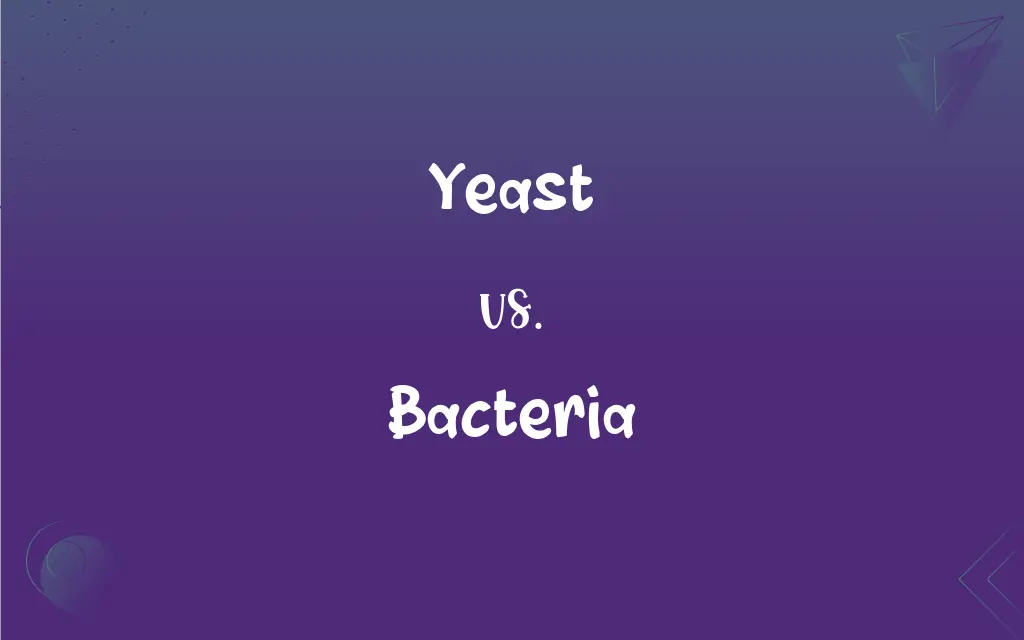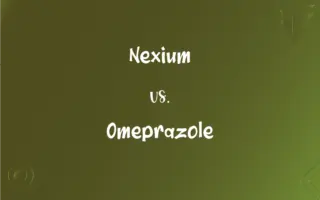Yeast vs. Bacteria: What's the Difference?
Edited by Aimie Carlson || By Janet White || Published on September 7, 2024
Yeast is a type of fungus used in fermentation, while bacteria are single-celled organisms involved in various biological processes.

Key Differences
Yeast and bacteria are two distinct types of microorganisms with crucial roles in both nature and various industries. Yeast, belonging to the fungi kingdom, is primarily used in the baking and brewing industries due to its fermentation capabilities. It converts sugars into alcohol and carbon dioxide, making it essential for producing bread, beer, and wine. Bacteria, on the other hand, are single-celled organisms with a wide range of functions, from decomposing organic matter to aiding digestion in the human gut. Unlike yeast, bacteria can be found in virtually every environment on Earth, including extreme conditions where other life forms cannot survive.
The cellular structure of yeast and bacteria differs significantly. Yeast cells are typically larger than bacterial cells and possess a nucleus, making them eukaryotic. Bacteria, as prokaryotes, do not have a nucleus; their genetic material is dispersed within the cell. This fundamental difference in cell structure affects how each organism reproduces and functions. Yeast usually reproduces asexually through budding, while bacteria reproduce through binary fission, a process where the cell divides into two identical cells.
Yeast and bacteria play diverse roles in human health and disease. Some yeast species, like Candida, can cause infections in humans, but others are beneficial for their probiotic effects. Bacteria also have a dual nature; while some are pathogenic, causing diseases such as strep throat or urinary tract infections, others are beneficial and essential for processes like fermentation in food production and nutrient absorption in the human digestive system.
In the environment, yeast and bacteria contribute to the decomposition of organic materials, recycling nutrients back into ecosystems. However, their roles and methods differ, with bacteria often breaking down substances yeast cannot, indicating their complementary roles in ecological processes. Additionally, yeast's fermentation ability is harnessed in biotechnology for producing biofuels, whereas bacteria's diverse metabolic capabilities are exploited for tasks ranging from oil spill cleanup to the production of antibiotics.
Understanding the differences between yeast and bacteria is not only crucial for microbiology but also for their application in food science, medicine, and environmental management. Their distinct biological characteristics and roles highlight the diversity of life and the complexity of microbial interactions in various processes.
ADVERTISEMENT
Comparison Chart
Kingdom
Fungi
Bacteria
Cell Type
Eukaryotic (with nucleus)
Prokaryotic (no nucleus)
Size
Generally larger
Generally smaller
Reproduction
Asexually through budding
Asexually through binary fission
Applications
Baking, brewing, biofuels
Fermentation, bioremediation, antibiotics
ADVERTISEMENT
Yeast and Bacteria Definitions
Yeast
Yeast is a single-celled fungus used in fermentation.
Yeast causes bread to rise by producing carbon dioxide.
Bacteria
Bacteria are single-celled microorganisms that can inhabit diverse environments.
Bacteria in the gut help digest food.
Yeast
Yeast is used in baking for its leavening properties.
Adding yeast to dough makes it fluffy and light.
Bacteria
Bacteria are used in the production of antibiotics.
Certain bacteria produce substances that kill or inhibit other microbes.
Yeast
Yeast can produce biofuels through fermentation.
Yeast fermentation is explored for sustainable energy solutions.
Bacteria
Bacteria play a key role in the nitrogen cycle.
Nitrogen-fixing bacteria enrich soil fertility.
Yeast
Yeast can convert sugars into alcohol and carbon dioxide.
Brewers rely on yeast to produce beer.
Bacteria
Some bacteria cause diseases, while others are beneficial.
Pathogenic bacteria can cause serious infections.
Yeast
Yeast is a model organism in genetic research.
Scientists use yeast to study cell division.
Bacteria
Bacteria can degrade pollutants in bioremediation processes.
Oil spills are sometimes cleaned up using bacteria.
Yeast
Any of various unicellular fungi of the genus Saccharomyces, especially S. cerevisiae, reproducing asexually by budding or sexually through the production of ascospores and capable of fermenting carbohydrates.
Bacteria
Plural of bacterium.
Yeast
Any of numerous fungi that exhibit a one-celled growth form and reproduce by budding, including certain candidas that can cause infections in humans.
Bacteria
(US) A type, species, or strain of bacterium.
Bacteria
Alternative form of bacterium.
Bacteria
Lowlife, slob (could be treated as plural or singular).
Bacteria
An oval bacterium, as distinguished from a spherical coccus or rod-shaped bacillus.
Bacteria
See Bacterium.
Bacteria
(microbiology) single-celled or noncellular spherical or spiral or rod-shaped organisms lacking chlorophyll that reproduce by fission; important as pathogens and for biochemical properties; taxonomy is difficult; often considered plants
FAQs
Can yeast cause infections?
Yes, some yeast species can cause infections, such as Candida albicans causing thrush.
What is yeast?
Yeast is a type of fungus used in fermentation and baking.
How do yeast and bacteria reproduce?
Yeast reproduces asexually through budding, while bacteria reproduce through binary fission.
Are all bacteria harmful?
No, while some bacteria cause diseases, many are beneficial and essential for ecological balance and human health.
What are bacteria?
Bacteria are single-celled organisms that play various roles in the environment, industry, and health.
How do yeast and bacteria contribute to environmental health?
They decompose organic matter, recycle nutrients, and some bacteria can detoxify pollutants.
How do yeast and bacteria differ in size?
Yeast cells are generally larger than bacterial cells.
Can bacteria live in extreme environments?
Yes, bacteria can thrive in extreme conditions, including hot springs and acidic environments.
Are yeast and bacteria visible to the naked eye?
Generally, they are not visible individually but can form visible colonies.
Can both yeast and bacteria be used in genetic engineering?
Yes, both can be genetically modified for research and industrial applications.
What roles do yeast and bacteria play in food production?
Yeast is used in baking and brewing, while bacteria are used in fermentation processes, such as making yogurt.
Can bacteria be used to clean the environment?
Yes, through bioremediation, bacteria can degrade or detoxify pollutants.
What scientific studies use yeast?
Yeast is widely used in studies of cell biology, genetics, and biochemistry.
Why is yeast important in brewing?
Yeast ferments sugars into alcohol and carbon dioxide, essential for beer and wine production.
What is the significance of yeast in biotechnology?
Yeast is used in genetic research, biofuel production, and as a tool in molecular biology.
What distinguishes pathogenic and non-pathogenic bacteria?
Pathogenic bacteria cause diseases, whereas non-pathogenic bacteria are harmless or beneficial.
How do antibiotics affect yeast and bacteria?
Antibiotics typically target bacteria and do not affect yeast, which is a fungus.
Do yeast and bacteria have a nucleus?
Yeast cells have a nucleus (eukaryotic), while bacteria do not (prokaryotic).
What is the role of bacteria in the human body?
Bacteria in the gut aid in digestion, synthesize vitamins, and protect against pathogens.
How can yeast infections be treated?
Yeast infections can be treated with antifungal medications.
About Author
Written by
Janet WhiteJanet White has been an esteemed writer and blogger for Difference Wiki. Holding a Master's degree in Science and Medical Journalism from the prestigious Boston University, she has consistently demonstrated her expertise and passion for her field. When she's not immersed in her work, Janet relishes her time exercising, delving into a good book, and cherishing moments with friends and family.
Edited by
Aimie CarlsonAimie Carlson, holding a master's degree in English literature, is a fervent English language enthusiast. She lends her writing talents to Difference Wiki, a prominent website that specializes in comparisons, offering readers insightful analyses that both captivate and inform.






































































